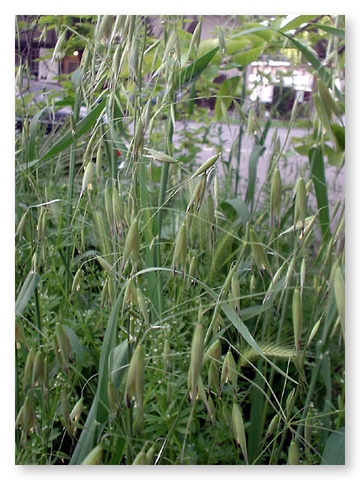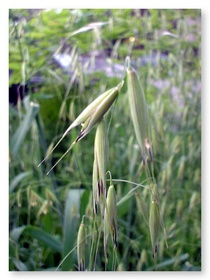
 Wild oats' open-panicled flowerheads are their most easily identifiable trait for the casual observer
Wild oats' open-panicled flowerheads are their most easily identifiable trait for the casual observer
Wild Oats (Avena fatua) are an annual herb/grass from the Poaceae (grass) family with long, flat leaf blades and jointed, hollow stems growing anywhere from one- to three-feet tall. A European, or Old World native with a ten-year seed viability, wild oats have since naturalized in the US and are largely considered an exotic plant pest & noxious weed which endangers natural habitats. Its Latin root derives from Avena, for oats and fatua, meaning foolish, insipid or worthless. Most wild oats germinate and emerge in the cool, moist conditions of early to mid-spring and bloom through early June. Its seedlings sport hairy foliage and mature plants are easily distinguished by their open panicled, nodding inflorescence. Wild oat is very apparently segmented with tall, pointed tongue-like ligules (that point at which each sheath section grows away from the main stalk); looking carefully, one can see that each ligule has jagged edges. Leaf blades of the wild oat generally have hairy margins, unlike the smooth bracts found on cultivated oats. Wild oats can be found throughout Davis in disturbed, rich soils, along drainage ditches and in culverts.
Despite it's maligned status in the agricultural world, wild oats have some redeeming medicinal value as a stress-reliever. Wild oats are said to counteract agitation from overwork and prolonged stress, though neither specifically a sedative nor stimulant. To quote Michael Moore, This is crispy critter medicine.
Additional information on wild oats can be found on the Invasive Species Initiative of The Nature Conservancy, hosted by UC Davis, as well as campus' Integrated Pest Management site. For a listing of other plants found in Davis, visit our Town Flora.



